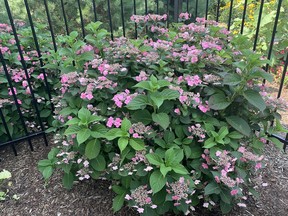Breadcrumb Trail Links
OpinionColumn
The world of hydrangeas is getting bigger in number and smaller in size.
Published Aug 08, 2025 • 2 minute read
 Pop Star hydrangea is shown. (John DeGroot) HandoutArticle content
Pop Star hydrangea is shown. (John DeGroot) HandoutArticle content
The world of hydrangeas is getting bigger in number and smaller in size.
Advertisement 2
This advertisement has not loaded yet, but your article continues below.
Article content
Early this spring, the president of the Lasalle Horticulture Club told me that in her town, you were hardly considered a legit Canadian unless you had a Ford F150 in the driveway and two hydrangeas in the front yard landscape.
Article content
Recommended Videos
Article content
Hydrangeas are king of the summertime garden, and their popularity continues to grow with each new season.
Top of charts is Incrediball, an improved version of the old Annabelle that Grandma grew in her garden.
Incrediball is a solid performer with monster-sized white blooms appearing in mid-July and persisting until September. In fall flowers begin to fade, becoming tan-coloured and dried by December.
If there is a negative side to Incrediball it would be that the plant grows to a beefy size of 150 centimetres, which might be too large for smaller landscapes in perennial flower gardens.
Advertisement 3
This advertisement has not loaded yet, but your article continues below.
Article content
Recognizing gardeners’ appetite for dwarf plants, several years ago nursery growers began their quest for smaller hydrangeas in a variety of colours.
The result is a proliferation of hydrangeas that grow to 100 cm or less, without compromising on hardiness, bloom length, performance and colour.
Wee Bit Giddy and Wee Bit Grumpy are two comically named hydrangeas growing to an ultimate size of 70 cm high. Both are Proven Winner selections, and both sit comfortably in the macrophylla or big leaf category of hydrangeas.
The former has cherry-red softball-sized blooms, while the latter has deep purple-blue flower coloured blooms if growing in acidic soil and red blooms if soil is alkaline.
Big leaf hydrangeas have deep green foliage, making the plant handsome looking even when not in flower. They perform best when grown in well-drained soil with sun or partial shade.
Advertisement 4
This advertisement has not loaded yet, but your article continues below.
Article content
The new dwarf cultivars of big leaf hydrangeas are rebloomers, practically guaranteeing bloom all summer long. Pruning is not necessary or recommended, for fear of cutting off flower buds.
Also in the big leaf category is Cherry-go-Round with deep cherry-red flowers arriving in late spring with new flowers appearing until early fall.
Similar, but slightly larger at 100 cm is Crimson with blooms that open in green, quickly turning to deep red.
For an interesting flower, Pop Star and Tiny Tuff Stuff have lace cap blooms flower heads that open wide on the margins and stay closed in the centres. Pop Star is delightfully pink while Tiny Tuff Stuff tends towards violet hues.
Those who prefer a small, big leaf hydrangea in traditional white, should look at Grin and Tonic which opens its bloom in lime green, becoming bright white in mid-summer. Flowers contrast nicely with the dark leaves, especially noticeable at nightfall.
Article content
Share this article in your social network

Comments are closed.